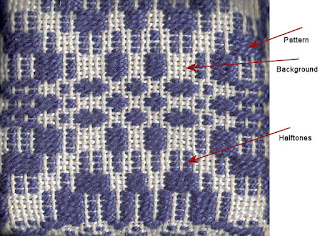 |
| “Wheel of Fortune” coverlet from the collection of the Metropolitan Museum |
Hannah had been married on October 28 to Moses Pollard (brother of Dorcas, who had helped her learn to weave) but she was still living with her parents and continuing to produce the goods she would need in her new home. Between the end of October and December 12, when she and Moses officially “went into housekeeping,” Hannah made a quilt, the aforementioned blanket, and at least two “coverleds.” These bed coverings served a practical purpose, of course, but they also would provide an extra degree of comfort and beauty in the Pollard home, while demonstrating Hannah’s skill at the loom.
 |
| Detail of a woven coverlet |
 |
| Overshot weave structure |
 |
| Example of a weaving draft |
The earliest American woven coverlet that can be definitively dated is from 1771, and women continued to make them into the 19th century, though by the 1820s professional weavers were also making more elaborate jacquard coverlets. As families moved west from New England into New York, Ohio, Indiana, and beyond, they brought the tradition of weaving coverlets with them. In certain parts of the south, particularly the mountain regions of Kentucky and Tennessee, domestic textile production remained an important part of the local economy well into the 1900s. In our next posts, we’ll look at early collectors of coverlets and their relationship with the movement to preserve hand weaving in Appalachia.

No comments:
Post a Comment